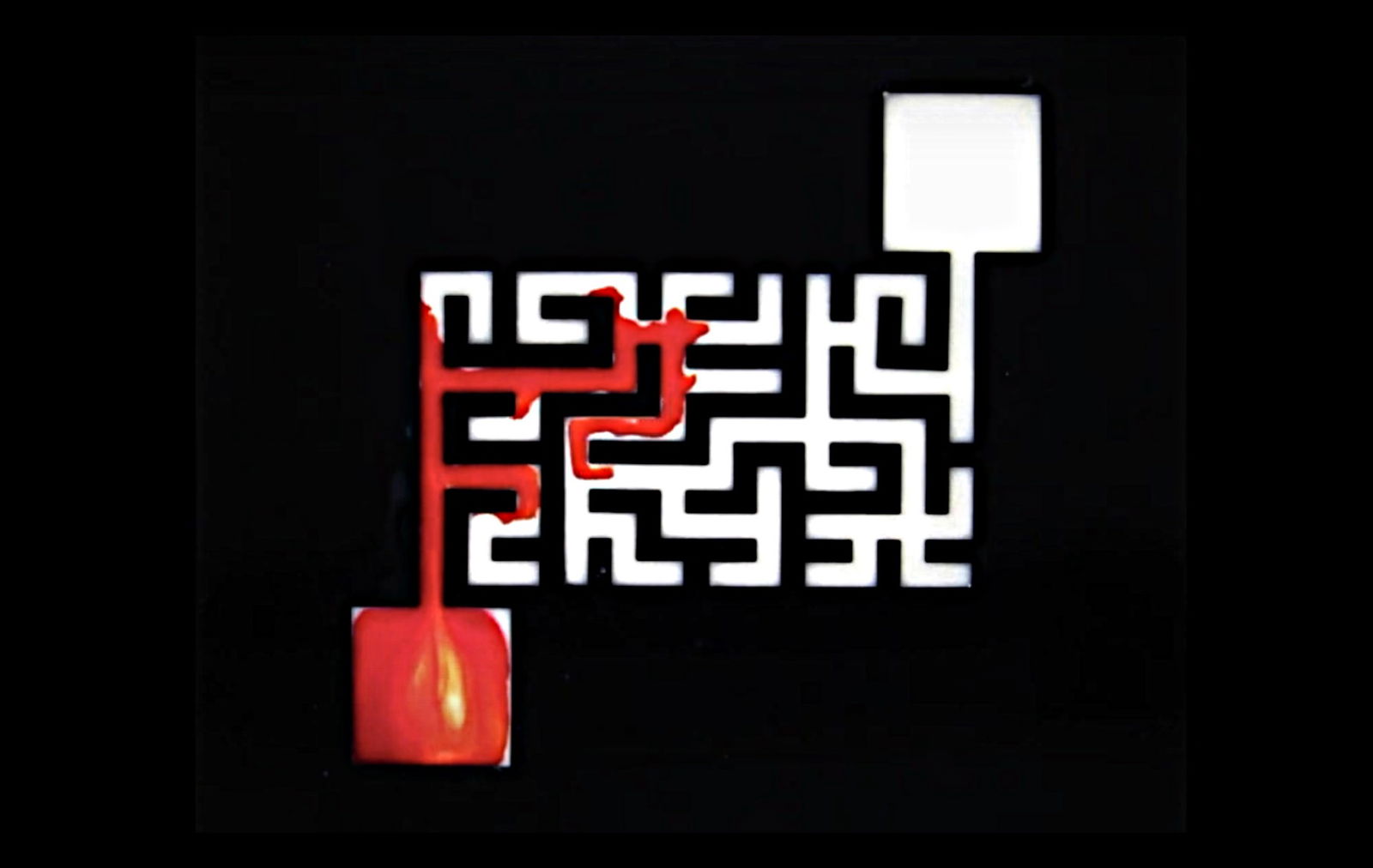Scientists have unraveled the mystery behind an “intelligent” liquid that can solve a maze without assistance, according to new research.
The team behind the discovery found that a combination of surfactants in soap and milk creates a resistance gradient, guiding the liquid along the correct path. The breakthrough could enhance fluid transport applications in complex systems that involve lung health and drug delivery.
In past research, an ‘intelligent’ liquid developed by Harvard researchers displayed a range of properties, including tunable springiness, adjustable optical properties, variable viscosity, and even the seemingly magical ability to shift between a Newtonian and non-Newtonian fluid.
The newly developed “metafluid” is the first to demonstrate the ability to solve a maze without interference.
Demonstration of Intelligent Liquid Began as a Tool for Learning
Initially designed to demonstrate the overall complexity of fluid systems, the maze-solving intelligent liquid display ultimately became an exhibit in the American Physical Society’s Gallery of Fluid Motion, where it has continually fascinated and perplexed observers. A video released by the research team shows how the liquid avoids incorrect paths while seemingly displaying the uncanny ability to “choose” the correct oath without any previous knowledge of the maze or outside interference.
“We came up with this experiment because we were having a hard time convincing people of certain effects happening for the problem of drag reduction,” said Paolo Luzzatto-Fegiz, University of California, Santa Barbara (UCSB) assistant professor of mechanical engineering in a statement announcing the team’s solution.
A fluid mechanics expert who has spearheaded research involving the modeling of flow and investigating drag, meaning the extremal resistive forces that act on solid objects when traveling through fluids, Luzzatto-Fegiz says his team was able to crack the code of how the intelligent liquid acts with “intelligence.”
“We had a hypothesis for how this worked,” the professor explained. “And this paper actually works out a mathematical model of that phenomenon.”
Mixture Solves Maze Thanks to Surfactant Forces
To understand how the intelligent liquid can choose its path rather than spreading out more evenly, as one might expect, the team looked into the dynamics of surface tension. Surface tension is defined as a liquid’s tendency to shrink into the minimum surface area possible when at rest. Surface tension is why insects like water striders can walk on the water’s surface without sinking or how drops of water can maintain their shape.


Surface tension can also be observed by filling a cup with water just beyond its rim. Done carefully, surface tension will allow the water to bulge at the surface slightly above the rim line without spilling over the sides.
The research team, which along with Luzzatto-Fegiz also included UCSB engineering professor Frederic Gibou and collaborators at Princeton University, the University of Manchester in the UK, and the Université de Rennes in France, tested an experiment composed of ink, soap, and milk. The soap is a surfactant, which reduces surface tension around the denser ink and initiates the mixture’s movement.
Still, this addition alone did not explain the ability of this seemingly intelligent liquid to choose its path to solve a maze. According to the researchers, the liquid’s magic ingredient is the invasion of milk, which contains its surfactants.
“The added surfactant (in the milk) and the preexisting one (in the soap) end up working together,” Luzzatto-Fegiz said.
In their published paper, the team outlines the mechanics behind the intelligent liquid and how the combined surfactants give the liquid its ability to solve the maze. For example, they note that the “endogenous” surfactant already present in the milk forms a “landscape of varying resistances” that pushes back on the mixture of soap and ink as it works through the maze.
For example, when the mixture encounters dead ends and small spaces where the pushback is significantly stronger, the resistance causes it to avoid that path. Conversely, when the liquid encounters a route with the most surface area, meaning the route toward the exit, the pushback is weaker. This type of resistance gradient results in an intelligent liquid that can effectively choose its path to solve a maze.
“That means the added surfactant instantly knows the layout of the maze,” Luzzatto-Fegiz explained.
Inspiring Improved Strategies for Several Fluid Transport Applications
The study’s authors conclude noting that their findings are based on previous studies on motion induced by a gradient in surface tension called the Marangoni effect. However, the team is the first to apply this principle to solve the mystery of the intelligent liquid that can solve a maze.
According to the authors, this newly discovered effect is a “new consequence” that hasn’t been studied yet. While still a concept, the team believes their work can offer new solutions to applications and processes involving “surfactant-driven transport in complex networks, such as lung airways.” They also believe their findings “can inspire improved strategies for drug delivery or fluid transport in complex systems.”
The study “Exogenous–Endogenous Surfactant Interaction Yields Heterogeneous Spreading in Complex Branching Networks” was published in Physical Review Letters.
Christopher Plain is a Science Fiction and Fantasy novelist and Head Science Writer at The Debrief. Follow and connect with him on X, learn about his books at plainfiction.com, or email him directly at christopher@thedebrief.org.

